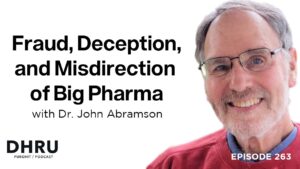Apr
16
What’s Wrong with American Healthcare
“The state of medicine is an index of the civilization of an age and country — one of the best, perhaps, by which it can be judged.” — Oliver Wendell Holmes (1869)
In the following excerpt from an Imprimis article by Dr. John Abramson, the author provides insights from both personal experience (as a medical patient) and professional research and observation (as a highly-lauded family practitioner and as a Harvard professor). Some very surprising, and often disturbing, facts are revealed about the medical/pharmaceutical industry. I think you will find them of interest, as well.
— — —

“I developed a serious cardiac arrhythmia, ventricular tachycardia, seven years ago. It worsened over the past summer and early fall, and over the past six weeks I’ve had several ambulance rides and hospitalizations. And my experience through this illustrates the good side as well as the bad side of medicine today.
On the good side, I was fortunate to have the attention of two world-class doctors who spent six hours, one going inside my heart, the other coming through my chest wall to the outside of my heart, to map electrically the aberrant signals in my heart and to ablate them. Since then, I’ve not had a problem.
On the bad side, two days after the procedure, I was in the intensive care unit when a cardiologist came by on rounds. He advocates a wider use of cholesterol-lowering statin medications than I do, and he started to cite the literature about why I should be taking more cholesterol-lowering medicine than I already was. I asked him if he had read the studies underlying that literature, and of course he had. I then asked him if he understood that the endpoint of many of those studies wasn’t really appropriate to determine the benefit of statins, and he acknowledged there was some debate about that. Finally, I asked if he was aware that when peer-reviewed articles are published in medical journals — even the most reputable medical journals — the peer reviewers don’t have access to the actual data from the clinical trials being reviewed. And he answered, somewhat meekly, that yes, he was aware of that.
In other words, he was aware that his recommendation that I increase my use of statin drugs was based entirely on incompletely vetted commercially-sponsored and largely commercially-influenced medical journal articles. This gets to the heart of the problem of the commercial takeover of the medical knowledge that doctors believe in and implement.
But before continuing that thought, let me step back and explain why I begin from the assumption that U.S. health care is on the wrong track.
An easy way to gauge the health of a country, and to compare the health of a country with that of other countries, is to look at average life expectancy. And if you look at a chart comparing average life expectancy in the U.S. with the average life expectancy of eleven other wealthy countries from 1980 to 2021, you will find that in 1980, the U.S. was just about equal with those other countries. But as the years have progressed since then, life expectancy in the U.S. has fallen further and further behind. Until 2014, our life expectancy was going up, but we were losing ground to the populations of other advanced countries.
By 2019, prior to COVID, life expectancy in the U.S. had fallen relative to that in the other countries so much that 500,000 Americans were dying each year in excess of the death rates of the citizens of those other countries. To exclude poverty as a factor in these numbers, a study looked at the health of privileged Americans — specifically, white citizens living in counties that are in the top one percent and the top five percent in terms of income. This high-income population had better health outcomes than other U.S. citizens, but it still had worse outcomes than average citizens of the other developed countries in such areas as infant and maternal mortality, colon cancer, childhood acute lymphocytic leukemia, and acute myocardial infarction.

Now combine this with the fact that we in the U.S. are paying an enormous excess over those other countries on health care. In the U.S., we spend on average $12,914 per person per year on health care, whereas that figure in the other comparable countries is $6,125. That comes to $6,800 more per person — and if you multiply that by 334 million Americans, we are spending an excess $2.3 trillion a year on health care — and getting poorer results.
Which means that our health care system is broken and needs fixing.
Prior to leaving office in 1961, President Eisenhower famously warned the nation about what he called the “military-industrial complex.” I suggest that we now have a medical-industrial complex that is sucking America’s wealth away from the other things that will make us healthier and create better lives for the American people.
Ask yourself, what ought to be the primary goal of American health care? To my mind it is this: to maintain and improve individual and population health most effectively and efficiently. And if that is correct, there are two critical questions we all need to ask: (1) Why are we failing so miserably to achieve this goal? and (2) Why are doctors and other health care professionals willing to go along with this dysfunctional system?
One of the fundamental reasons for the disparity between the health of Americans and the health of people in other wealthy developed countries is that our medical-industrial complex has taken control over what doctors and the public accept as medical knowledge. This is something that has evolved over time.
Back in 1981, I was finishing my medical residency and starting a two-year fellowship, which is when I learned my research skills. At that time, my colleagues and I would spend hours dissecting the articles in medical journals, and commercial bias was never an issue. But 1981 turned out to be a pivot point. Derek Bok, the president of Harvard University, said in Harvard Magazine that year that the university’s reliance on industry funding for research was causing “an uneasy sense that programs to exploit [i.e., make money from] technological development are likely to confuse the university’s central commitment to the pursuit of knowledge.” He explained that because grants from the National Institutes of Health and the National Science Foundation were declining, scientific researchers were turning to commercial sources for funding.
Along the same lines, a 1982 article in the journal Science, ‘The Academic-Industrial Complex,’ pointed out that universities that had been pursuing knowledge for its social and scientific value had been suddenly drawn into the marketplace and were pursuing knowledge for commercial value. We today have grown accustomed to an environment where it’s normal for professors at medical schools to have commercial relationships. But it wasn’t always that way, and it doesn’t have to be that way in the future.

A second factor in the evolution I’m describing was the passage by Congress in 1980 of the University and Small Business Patent Procedures Act — also known as the Bayh-Dole Act. When Japanese cars entered U.S. markets in the late 1970s, it was widely believed that the Japanese government was supporting the development of those imports in order to help Japanese car manufacturers compete against their U.S. counterparts. Many thought that the same loss of competitive edge was happening in science: research taking place at universities wasn’t being properly commercialized because the universities had no financial incentive. The Bayh-Dole Act aimed to remedy that by allowing universities and other nonprofit research institutions to commercialize discoveries made by their scientists while conducting federally-funded research by retaining any profits — including profits from patents on pharmaceuticals. With that, universities became players in the marketplace and were absorbed into the medical-industrial complex….
The New England Journal of Medicine survey I cited before contained two other findings worth noting. In 24 percent of clinical trial agreements, the sponsor (meaning the drug company) ‘may include its own statistical analysis in manuscripts [i.e., journal articles].’ And even more outrageously, 50 percent of clinical trial agreements allow the sponsor to ‘write up the results for publication and the investigators may review the manuscript and suggest revisions.’ In other words, 50 percent of the contracts that academic medical centers make with drug companies allow the drug companies to ghostwrite the articles. The researchers who are the named authors of the articles have the right to suggest revisions but not to make actual corrections or edits. This is not academic freedom. Nor is it an arrangement in which medical science is going to serve the interest of the American people….
[T]he biomedical market is not like Adam Smith’s basic market in the 1700s — it’s not a market where people shop for their bread, meat, and beer, and where they can directly assess the quality of the information, the quality of the product, and whether the price is fair or not. Biomedical products are not directly-experienced goods like bread, meat, and beer. They are what economists call ‘credence goods’ — goods that can’t be evaluated directly by the purchaser. Rather, consumers must rely on the evaluation of experts. And with prescription drugs, the manufacturers have a monopoly on the information.”
— — —
This is not by any means an anti-capitalism article. However, it serves as another reminder of just how much we are at the mercy of the greedy and unscrupulous. And I didn’t even quote anything he said about the issue of excess costs… Fortunately, Abramson has a few suggestions for curing, or at least alleviating the symptoms of, our sick healthcare system.
The article was adapted from a recent talk Abramson gave at Hillsdale College. If any of the above concerns you, you owe it to yourself to read the whole thing. If you want to read more from Abramson, he is the author of Overdosed America: The Broken Promise of American Medicine and the more recent Sickening: How Big Pharma Broke American Health Care.















